Motocultores and Motoazadas for the orchard. Differences and how they work
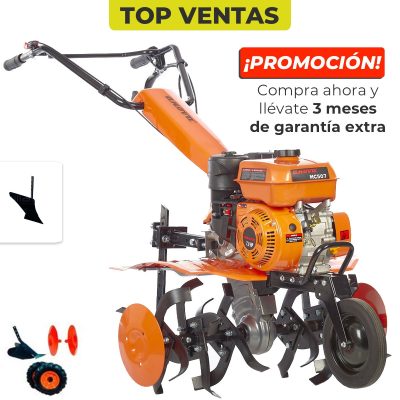
In today’s post we will talk about what a motorized cultivator and a motorized tiller or mechanical mule are and how they work. These are two of the most used gardening machines for tilling the land and preparing the orchard soil before planting crops.
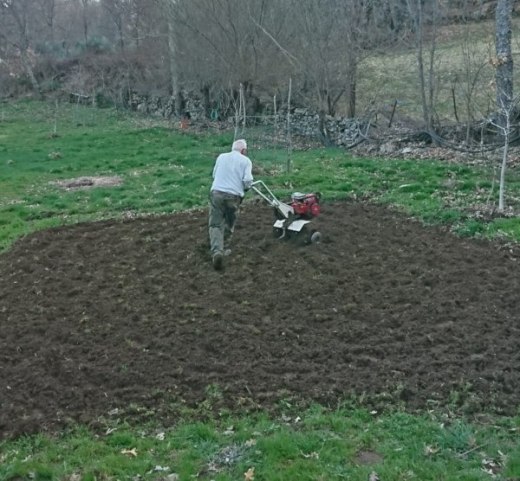
As we will see, although they have almost the same function, there are some differences between a power tiller and a power tiller (both in size and in components and handling).
What is a motocultor or a motoaza?
Power tillers and tillers (also known as «mechanical mules») are small agricultural machines used to loosen hard ground, clear or remove weeds, and aerate the substrate in preparation for sowing or planting.
Accessories or small implements can be attached to many models of tillers and tillers to carry out not only tilling or plowing the land, but also other tasks such as forming furrows or ridges, fertilizing, sowing, mowing the lawn, applying phytosanitary products to eliminate pests and diseases. …
The basic components of motoazadas or motocultores are:
- Engine: diesel, gasoline or battery-powered electric (minimum power between 5-8 CV -greater in larger motor cultivators to which implements or trailers are to be attached-).
- Gearbox, Transmission System, and Shift Lever: These machines typically have one or more forward gears, neutral, and reverse. The gears are selected by operating the gear lever and the clutch (which is usually in the lever).
- Starting device: it can be manual or rope or electric (with key or switch).
- Handles or handlebars to support the machine (with handles to stop its operation, accelerate the march or engage the engine).
- Rotary axis with blades or cutters (milling machine or rotavator): the number of cutters (usually between 3 and 6) determines the working width of the machine, which is usually between 30 and 60 cm. Normally, the working depth can also be adjusted by means of a lever that raises or lowers the rotavator shaft.
- Screen or protective devices for mobile elements
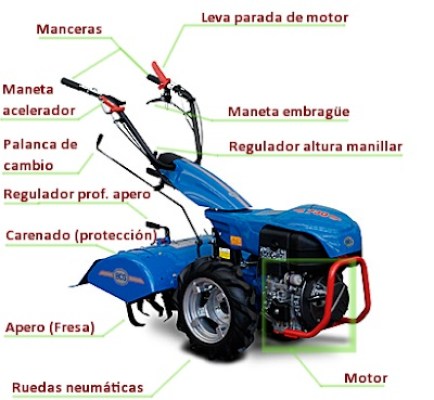
In the case of the motocultor, as we will see below, another of the components are the drive wheels, which the mechanical mule or motorized tiller lacks.
Differences between a motorized cultivator and a motorized hoe
Normally motorized tillers (lighter and cheaper) are used to till small surfaces in the home orchard or garden, while motorized tillers are used for larger extensions and harder work, so their weight and size is greater than that of motohoes.
Power tillers are said to be two-wheel tractors or single-axle tractors, since they are small self-propelled vehicles that have an axle with two driving wheels that allow the machine to move forward.
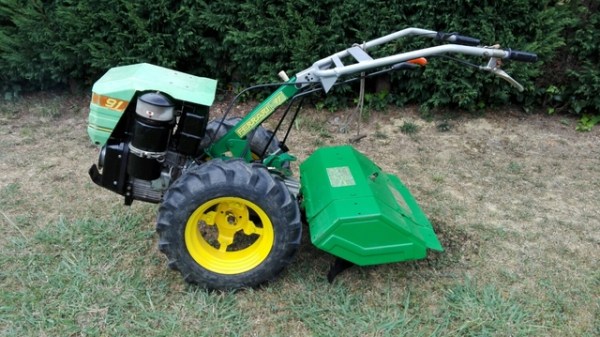
This translates into greater ease of use and less effort and time to till the same surface. Although it is larger and heavier, using a tiller is less tiring than a small mechanical mule or tiller because the drive wheels absorb part of the weight of the machine and also the vibrations and pulls caused by the resistance of the cutters when moving forward. All this, how could it be otherwise…, at the expense of its higher price: for the same power, a motorized cultivator will always be more expensive than a motorized tiller.
In motor hoes, on the other hand, the movement of the motor is transmitted only to the axis of the cutters or blades, which is what generates the advance of the machine (they may have a small support wheel -generally in the front part- but it is not driven by the motor).
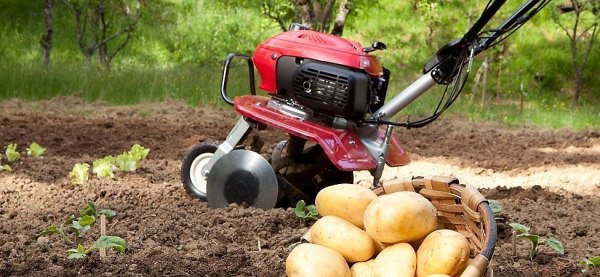
Another difference between a power tiller and a power tiller is the working depth. In motorized tillers it is greater (it can reach up to 30 cm) because, as we have already seen, these machines do not have wheels that limit the depth at which the cutters and blades are inserted.
Types of motoazadas or motocultores
These are some of the types of motor tillers and motor cultivators most used to prepare the soil:
- Motor tillers and motor cultivators with a gasoline engine: more common in less powerful machines (motor tillers or small motor cultivators).
- Diesel Tillers and Tillers – These machines are more expensive but tend to last longer and are cheaper to fuel.
- Motorized cultivators and tillers with electric motor and rechargeable battery: electric tools and machines do not require maintenance and generate less noise and vibrations than those with diesel or gasoline engines, but their power is limited, so they are usually used for small plots of land (orchards and gardens homemade).
- Large tractors with seat and trailer: they are used for extensions of several hectares and usually have an accessory PTO to connect other implements such as a sprayer for phytosanitary treatments, a seeder or a lawnmower.
- Motorized hoe to make furrows: an accessory tool that replaces the milling machine is connected to the machine: the auger bed machine.
What machine to use to till the soil in the garden or to lay grass in the garden
To plow the soil of an orchard and prepare it for planting, it is most common to use a motorized tiller. One of the main reasons is the greater working depth of this machine (up to 30 cm or more), which is necessary to condition the soil to the depth that vegetable roots reach.
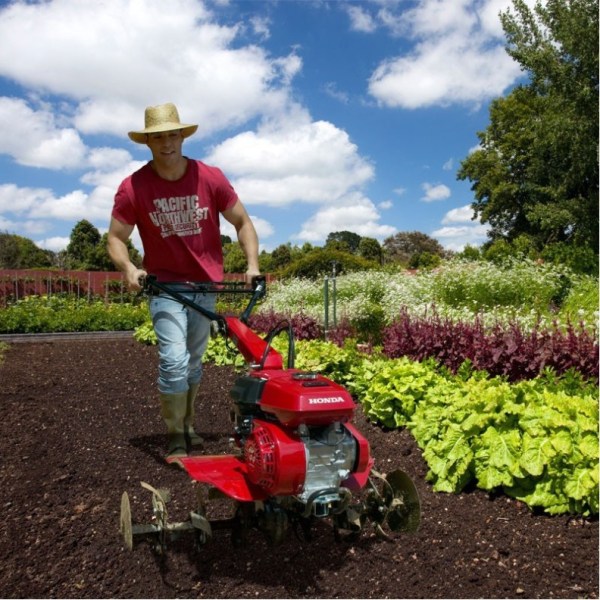
On the other hand, to prepare the soil of a large garden in order to sow grass, the power tiller is more suitable. Thanks to its greater power and size, the tiller shreds the soil much more, but to a lesser depth (than that necessary for the grass to grow, with much smaller roots than those of the garden plants). In addition, its easy handling will greatly reduce the work time and effort that would be involved in tilling a large area with a small motorized tiller or mechanical mule.
If you have an orchard tiller, it can also be adapted to prepare the ground for sowing grass. Work must be done with the engine revved to the maximum and limit the depth of the work so that the milling machine blades work only in the most superficial layer of the soil.
How to use a tiller to prepare the garden soil
Below is a video of a motorized tiller working in the orchard. In it they explain to us how to circulate with the motorized tiller or mechanical mule, as well as some details about preparing the machine before tilling the soil or setting it up beforehand.
Before using both the power tiller and the power tiller, it is very important to inspect the area and free it from stones, branches and other objects that are at risk of wrapping around the blades or being thrown violently by them.
Although it does not belong to our Agrohuerto TV channel, I also leave you with this other video about motor tillers and power tillers since I found it very useful and instructive. In which we can see live the main differences between a power tiller and a power tiller and how these two machines work to till the soil.
References
- Gil Sierra, J., 1994. Motocultores and motoazadas. Rural Life, No. 11, p. 41-43.
- Gracia López, C. & Bernard G, JJ, 1995. Machinery for horticulture. Horticulture Magazine, Vol. 104, p. 29-35.
- Gracia López, C., 1997. The option of the motocultor. Analysis of motocultores and motoazadas as an alternative for the farmer. Rural Life Magazine, No. 52, p. 58-62.
- Márquez Delgado, L., 2012. The motocultores. Agrotechnical. Notebooks of Agronomy and Technology, nº 5, pag. 34-39.
- Alva Montoya, CR, 2016. Tillage with motorized cultivators, motorized tiller and traditional tillage on terraces, in family farming – Barrio Bajo peasant community, Matucana – Lima. Final thesis to opt for the Degree of Agricultural Engineer. La Molina National Agrarian University, Lima (Peru).


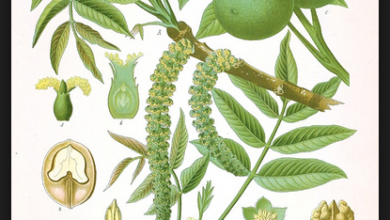
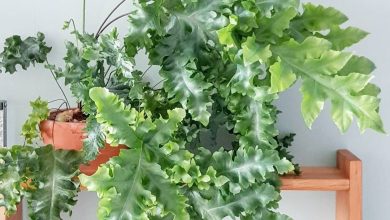
![Photo of How to Plant Padrón Peppers: [Complete Guide]](https://www.complete-gardening.com/wp-content/uploads/2022/08/how-to-plant-padron-peppers-complete-guide-390x220.jpg)